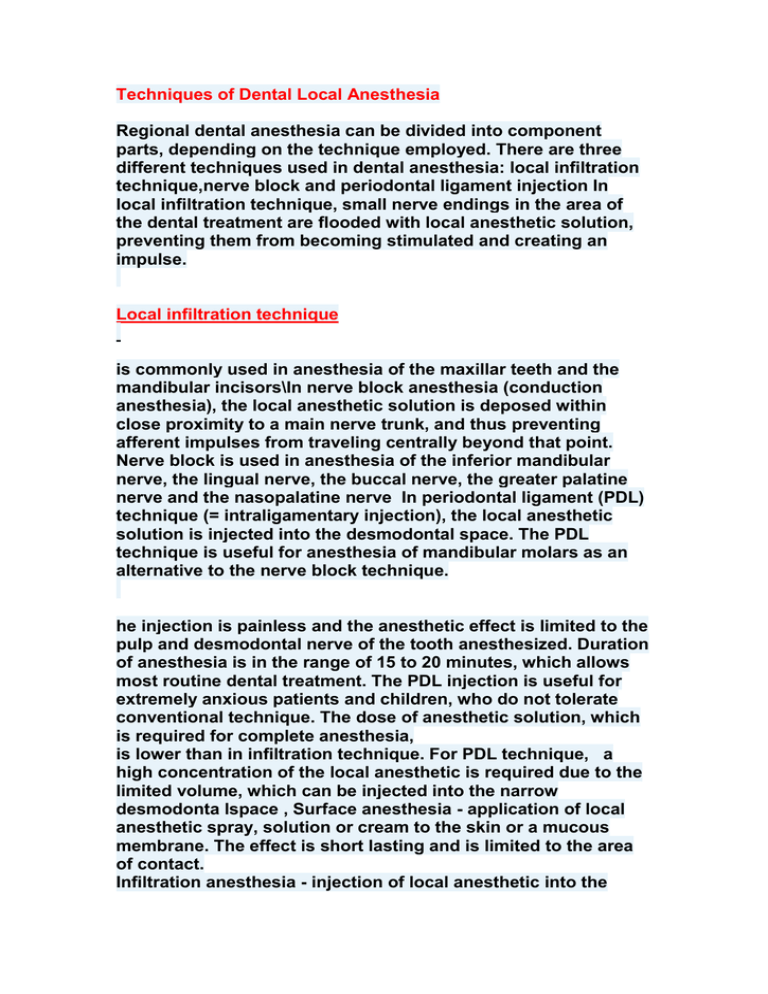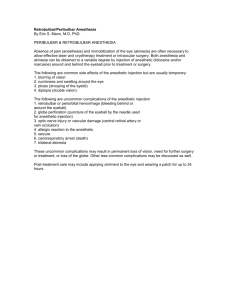Techniques of Dental Local Anesthesia
advertisement

Techniques of Dental Local Anesthesia Regional dental anesthesia can be divided into component parts, depending on the technique employed. There are three different techniques used in dental anesthesia: local infiltration technique,nerve block and periodontal ligament injection In local infiltration technique, small nerve endings in the area of the dental treatment are flooded with local anesthetic solution, preventing them from becoming stimulated and creating an impulse. Local infiltration technique is commonly used in anesthesia of the maxillar teeth and the mandibular incisors\In nerve block anesthesia (conduction anesthesia), the local anesthetic solution is deposed within close proximity to a main nerve trunk, and thus preventing afferent impulses from traveling centrally beyond that point. Nerve block is used in anesthesia of the inferior mandibular nerve, the lingual nerve, the buccal nerve, the greater palatine nerve and the nasopalatine nerve In periodontal ligament (PDL) technique (= intraligamentary injection), the local anesthetic solution is injected into the desmodontal space. The PDL technique is useful for anesthesia of mandibular molars as an alternative to the nerve block technique. he injection is painless and the anesthetic effect is limited to the pulp and desmodontal nerve of the tooth anesthesized. Duration of anesthesia is in the range of 15 to 20 minutes, which allows most routine dental treatment. The PDL injection is useful for extremely anxious patients and children, who do not tolerate conventional technique. The dose of anesthetic solution, which is required for complete anesthesia, is lower than in infiltration technique. For PDL technique, a high concentration of the local anesthetic is required due to the limited volume, which can be injected into the narrow desmodonta lspace , Surface anesthesia - application of local anesthetic spray, solution or cream to the skin or a mucous membrane. The effect is short lasting and is limited to the area of contact. Infiltration anesthesia - injection of local anesthetic into the tissue to be anesthetized. Surface and infiltration anesthesia are collectively topical anesthesia. Field block - subcutaneous injection of a local anesthetic in an area bordering on the field to be anesthetized. Peripheral nerve block - injection of local anesthetic in the vicinity of a peripheral nerve to anesthetize that nerve s area of innervation. Plexus anesthesia - injection of local anesthetic in the vicinity of a nerve plexus, often inside a tissue compartment that limits the diffusion of the drug away from the intended site of action. The anesthetic effect extends to the innervation areas of several or all nerves stemming from the plexus. Epidural anesthesia - a local anesthetic is injected into the epidural space where it acts primarily on the spinal nerve roots. Depending on the site of injection and the volume injected, the anesthetized area varies from limited areas of the abdomen or chest to large regions of the body. Spinal anesthesia - a local anesthetic is injected into the cerebrospinal fluid, usually at the lumbar spine (in the lower back), where it acts on spinal nerve roots and part of the spinal cord. The resulting anesthesia usually extends from the legs to the abdomen or chest. Intravenous regional anesthesia (Bier s block) - blood circulation of a limb is interrupted using a tourniquet (a device similar to a blood pressure cuff), then a large volume of local anesthetic is injected into a peripheral vein. The drug fills the limb s venous system and diffuses into tissues where peripheral nerves and nerve endings are anesthetized. The anesthetic effect is limited to the area that is excluded from blood circulation and resolves quickly once circulation is restored. Local anesthesia of body cavities (e.g. intrapleural anesthesia, intraarticular anesthesia) Adverse effects; Adverse effects depend on the local anesthetic agent, method, and site of administration and is discussed in depth in the local anesthetic sub-article. Overall the effects can be: 1. localized prolonged anesthesia or paresthesia due to infection, hematoma, excessive fluid pressure in a confined cavity, and severing of nerves & support tissue during injection, 2. systemic reactions such as depressed CNS syndrome, allergic reaction, vasovagal episode, and cyanosis due to local anesthetic toxicity. 3. lack of anesthetic effect due to infectious pus such as an abscess.






